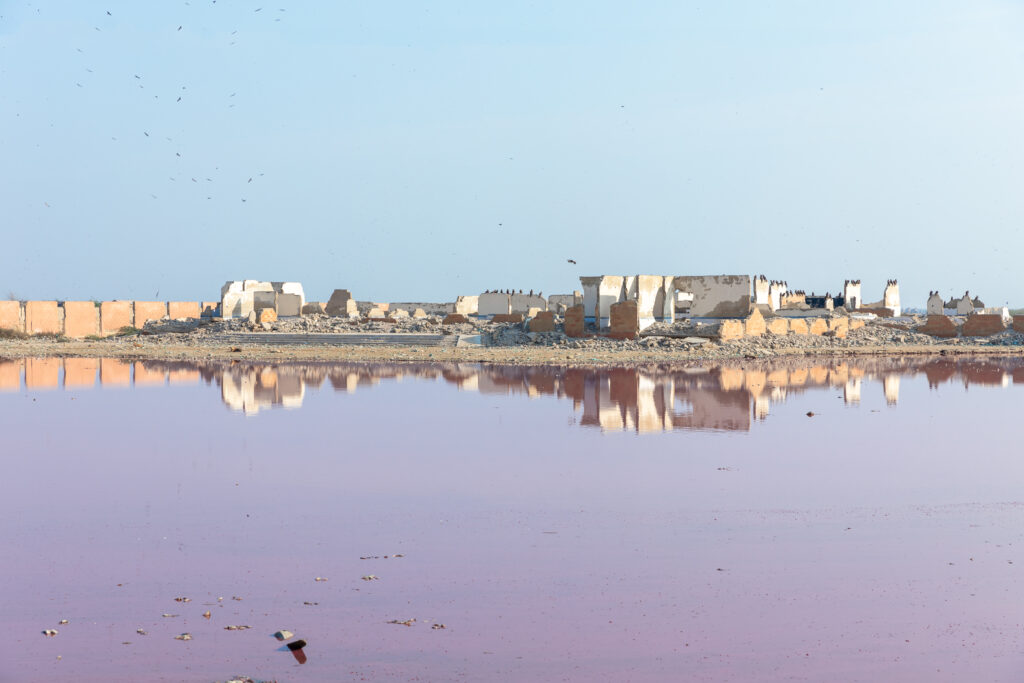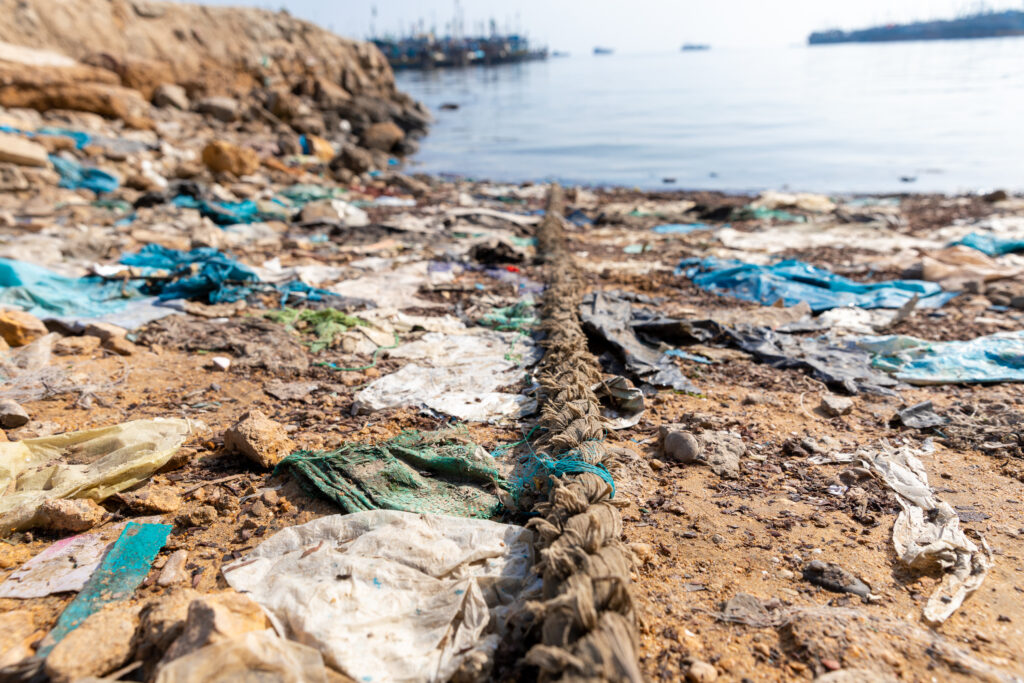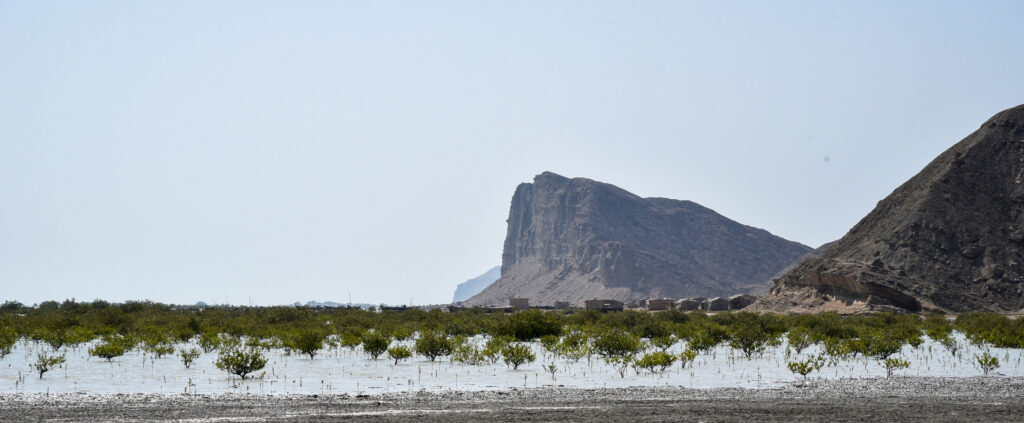- By UNDP – Pakistan
- Story by Shahzad Ahmad, Communications Officer, UNDP Pakistan
- Background
Stretching across about 1,000 kilometers alongside the Arabian Sea, Pakistan’s coastline serves as a vibrant center of economic activity and a vital lifeline for more than 22 million people in the country.
The coastal regions host fishing grounds, a thriving seafood industry, and seaports that offer significant employment and income opportunities to millions of residents.
“The sea is a magnificent universe offering a wealth of resources similar to a bank, vital to our sustenance and prosperity,” described Gul Muhammad, a fisher-folk from Mubarak village, Karachi.



A skilled fisherman prepares himself on his hand-crafted wooden kayak to reach his awaiting fishing vessel off the shores of Mubarak Goth.
However, the coastal areas are vulnerable to natural and climate induced disasters, resulting in loss of lives and livelihoods.
“The coastal area of Pakistan is vulnerable to tsunami events due to its location on the edge of the Arabian plate, which collides with the Eurasian plate,” said Ameer Hyder, who heads the National Tsunami Early Warning Center at the Pakistan Meteorological Department. “Pakistan has experienced similar calamitous events in the past; the 1945 earthquake triggered a tsunami resulting in the loss of more than 4,000 lives.”


To mitigate the risks from such disasters, with support from Government of Japan, UNDP has successfully completed the US $3.7 Million project; “Strengthening tsunami and earthquake preparedness in coastal areas of Pakistan” under Climate Change Adaptation and Mitigation-II.

- Partnerships
The project established robust partnership with the Government of Pakistan and offered policy support, institutional strengthening, capacity enhancement, research, analysis, and installation of early warning system.
The collaboration with key stakeholders such as National and Provincial Disaster Management Authorities (NDMA and PDMAs), Pakistan Meteorological Department (PMD), Pakistan Red Crescent Society (PRCS), NED University of Engineering and Technology, and district authorities has been critical in achieving its goals. This has resulted in better coordination and implementation of interventions on the ground.
- Risk Assessment and Policy Framework
The project collaborated with NED University and conducted a detailed tsunami risk assessment exercise in coastal areas, providing valuable data for identifying disaster preparedness and response planning.
A detailed Disaster Preparedness, Mitigation and Response Plan (DPMRP) was developed, highlighting vulnerable areas and potential consequences of a disaster. Based on this assessment, the project revised national tsunami SoPs and formulated tsunami building bylaws.
A policy framework was also developed on National School Safety Guidelines on earthquake and Tsunami preparedness. These efforts supported relevant authorities in adopting a coordinated and integrated approach to disaster risk reduction.


- Early Warning Systems
The project set up four 120 hertz broadband stations enabling automatic analysis and monitoring of earthquakes and tsunamis.
UNDP has installed five satellite-based early warning siren systems at densely populated coastal areas. Latest advanced software now enables the recording of important parameters and prepares intensity shake maps, reducing the time for issuing early warnings.




- Drilling Activity
The project conducted community drills to raise awareness of the system and how to react, upon hearing the sound of the siren.


- Emergency Shelters
The project designed and built 14 multi-purpose emergency shelters in government owned lands. Located in high and safe areas, these elevated halls are constructed with materials and methods to resist the impact of a disaster.



The project retrofitted 19 facilities (13 schools and 06 health facilities) in the coastal area to improve their resilience to earthquakes and tsunamis. The buildings were assessed for vulnerabilities and underwent structural modifications and reinforcements.
These retrofitted buildings contribute to community safety and well-being and ensure access to essential services during natural disasters. Along with offering physical protection, the shelters are equipped with basic amenities like separate space for women and men, water, washrooms, kitchen, food, and medical supplies, as well as information systems to help coordinate response efforts.



- Awareness
The distribution of 10,000 Information, Education and Communications (IEC) materials played a crucial role in sensitizing the community to take precautionary measures, create evacuation plans, build survival kits and how to stay informed and participate in drills. Also, 7 wall murals were painted on visible public places


- Collaboration with local communities
In partnership with Pakistan Red Crescent Society (PRCS), the project established 30 village Disaster Risk Management Committees (DRMC), youth groups, and emergency response teams in three coastal districts. A total of 1,366 (848 women) community members trained on coastal hazards. These groups will facilitate recovery, evacuation, and rescue assistance during a disaster. Additionally, 30 community resource centers were established in target districts to further strengthen these committees.





The project has established three Emergency Operations Cells, linked with the provincial Emergency Operation Cell to ensure a coordinated and effective response during the disaster. A total of 161 officials from provincial and district Disaster Management Authorities were trained on search and rescue operations, tsunami, earthquake, and coastal hazard preparedness.
- Enterprise Development
The project facilitated enterprise development training for 210 women in the target districts, empowering them to seize opportunities for income generation and deal with the economic consequences of natural disasters.

- Environemntal Challenges to Coastal area
The sea in Karachi is polluted by untreated waste, chemicals, and fumes from factories, as most of the city’s garbage and wastewater is disposed of there. This pollution has significantly reduced the once abundant fish population and forcing fisherfolks to venture further out to sea.

- Mangrove Plantation
The project planted 410,000 mangrove seeds on 100 hectares in coastal areas of Gwadar district, which contributed significantly to the protection of coastal communities from natural disasters. Mangroves serve as natural barriers against tsunamis, flooding, erosion and provide habitats for marine species. Additionally, mangroves absorb significant amounts of carbon dioxide to help achieve carbon neutrality.

- Impact
As a result of the project interventions, the coastal communities of Pakistan are now better equipped to face the challenges of tsunamis and earthquakes, and the lessons learned from this project can be applied in other disaster-prone communities around the world.

